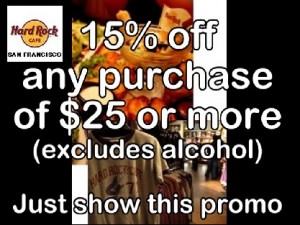 Proximity marketing is the next way that advertisers will get you. If you’re walking at the Pier 39 tourist attraction in San Francisco, you may feel a beep on your cell phone. That’s Intera Group‘s proximity marketing, sending you a message to redeem a coupon at the nearby Hard Rock Cafe and store.
Proximity marketing is the next way that advertisers will get you. If you’re walking at the Pier 39 tourist attraction in San Francisco, you may feel a beep on your cell phone. That’s Intera Group‘s proximity marketing, sending you a message to redeem a coupon at the nearby Hard Rock Cafe and store.
Over the past seven months, Intera and the pier’s Hard Rock Cafe have sent 100,000 messages to consumers walking by with their cell phones in the “discoverable” Bluetooth mode. The Hard Rock sends promotions that are immediately redeemable at the restaurant or store. Bob Boemer, head of sales and marketing for the local Hard Rock, said in a statement that the results have been outstanding.
 Pleasanton, Calif.-based Intera Group is a 20-year-old company that operates several thousand pay phones around the country. It started the proximity marketing business in part to take advantage of the fact that some of its pay phones are in ideal locations, such as at Pier 39, where 12 million tourists visit every year. Competitors may include outdoor marketing companies such as CBS Outdoor and Clear Channel. Agencies such as Kinetic Worldwide and ipsh! can provide the advertisers who are already enthusiastic about digital media.
Pleasanton, Calif.-based Intera Group is a 20-year-old company that operates several thousand pay phones around the country. It started the proximity marketing business in part to take advantage of the fact that some of its pay phones are in ideal locations, such as at Pier 39, where 12 million tourists visit every year. Competitors may include outdoor marketing companies such as CBS Outdoor and Clear Channel. Agencies such as Kinetic Worldwide and ipsh! can provide the advertisers who are already enthusiastic about digital media.
Kevin Thornton, chief executive of Intera, said that the company has set up a number of Bluetooth networks at Pier 39, covering about 5 percent of the area. Each Bluetooth network is set up near a place where people congregate for a long time, such as a spot for viewing sea lions, a tour bus waiting area, or the queue for the aquarium. Thornton said other national brands plan to start marketing at the Pier 39 location.
June 5th: The AI Audit in NYC
Join us next week in NYC to engage with top executive leaders, delving into strategies for auditing AI models to ensure fairness, optimal performance, and ethical compliance across diverse organizations. Secure your attendance for this exclusive invite-only event.
 As annoying as these marketing messages could be, Thornton says that the company hasn’t gotten a single complaint yet. (Maybe consumers don’t know how to complain?)
As annoying as these marketing messages could be, Thornton says that the company hasn’t gotten a single complaint yet. (Maybe consumers don’t know how to complain?)
One reason is that the Bluetooth messages are carried wirelessly over a 200-foot range radio network, making them much more relevant as ads, location wise. They’re targeted at someone who is already at the place where they might take advantage of the promotion. The messages also don’t cost the consumer anything — in contrast to text messages — because they don’t go over the cell phone network.
Also, consumers have to put their phones in “discover” to receive the messages. Only about one in five cell phone users does this. To prompt them, Intera puts up signs saying that consumers can get deals if they do so.
After the successful test, Thornton said he is hopeful the Hard Rock will roll the ad system out in more locations. Other places that can use it are gas stations, hotels, and high-trafficked tourist spots.
By the end of this year, Thornton said he expects to have the proximity marketing available in 1,000 places. Proximity marketing has been in place for a few years in Europe, South Africa, and Australia — generally areas where mobile marketing is more advanced. Intera can use equipment from companies such as Blip Systems in Denmark, Kameleon in France, and Qwikker in the U.S.

